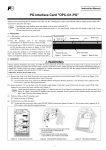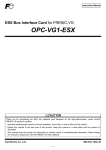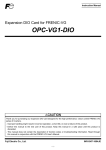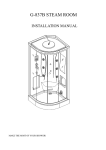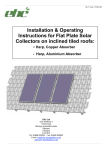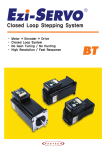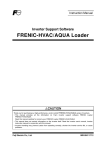Download PG Interface Card 5V Line Driver OPC-G1
Transcript
Instruction Manual PG Interface (5 V Line Driver) Card "OPC-G1-PG2" Thank you for purchasing this PG interface card or 5 V line driver card (hereinafter called PG interface card), "OPC-G1-PG2." Installing this card to your FRENIC-MEGA enables vector control with speed sensor. The FRENIC-MEGA has three option connection ports--A-, B-, and C-ports. Connect this PG interface card to the C-port. Do not connect it to any other port. 1. Check that: (1) A PG interface card and two screws (M3 8) are contained in the package. (2) The PG interface card is not damaged during transportation--no defective devices, dents or warps. (3) The model name "OPC-G1-PG2" is printed on the PG interface card. (See Figure 1.) Screw hole (left) J1 If you suspect the product is not working properly or if you have any questions about your product, contact the shop where you bought the product or your local Fuji branch office. CN1 Release knob Positioning cutout Model name Screw hole (right) Figure 1 Front of Card Figure 2 Back of Card 2. Installation Before starting installation and wiring, turn OFF the power and wait at least five minutes for inverters with a capacity of 22 kW or below, or at least ten minutes for inverters with a capacity of 30 kW or above. Make sure that the LED monitor and charging lamp are turned OFF. Further, make sure, using a multimeter or a similar instrument, that the DC link bus voltage between the terminals P(+) and N(-) has dropped to the safe level (+25 VDC or below). Otherwise, electric shock could occur. (1) Remove the front cover from the inverter and expose the control printed circuit board (control PCB). As shown in Figure 3, the interface card can be connected to the C-port (CN6) only. To remove the front cover, refer to the FRENIC-MEGA Instruction Manual, Section 2.3. For inverters with a capacity of 30 kW or above, open also the keypad enclosure. (2) Insert connector CN1 on the back of the PG interface card (Figure 2) into the C-port (CN6) on the inverter's control PCB. Then tighten the two screws that come with the card. (Figure 4) Check that the positioning cutout (Figure 1) is fitted on the tab ( in Figure 4) and connector CN1 is fully inserted ( in Figure 4). Figure 5 shows the PG interface card correctly mounted. Do not connect the interface card to the ports other than C-port. Doing so may damage the card. (3) Perform wiring on the PG interface card. Refer to Section 3 "Wiring." (4) Put the front cover back into place. To put back the front cover, refer to the FRENIC-MEGA Instruction Manual, Section 2.3. For inverters with a capacity of 30 kW or above, close also the keypad enclosure. Tab Fit the positioning cutout of the card over the tab on the inverter to determine the mounting position. Insert connector CN1 on the card into the C-port (CN6) on the inverter's control PCB. Figure 3 In the case of 0.4 kW Figure 4 Mounting PG Interface Card -1- Figure 5 Mounting Completed 3. Wiring In general, the covers of the control signal wires are not specifically designed to withstand a high voltage (i.e., reinforced insulation is not applied). Therefore, if a control signal wire comes into direct contact with a live conductor of the main circuit, the insulation of the cover might break down, which would expose the signal wire to a high voltage of the main circuit. Make sure that the control signal wires will not come into contact with live conductors of the main circuit. Failure to observe these precautions could cause electric shock or an accident. Noise may be emitted from the inverter, motor and wires. Take appropriate measures to prevent the nearby sensors and devices from malfunctioning due to such noise. An accident could occur. Perform wiring properly, referring to the "Terminal Allocation and Symbol Diagram," "Terminal Specifications," and "Internal Block Diagram" shown below. J1 PI EXT Table 1 Terminal Specifications Terminal Size INT +5 VDC PO M2 Tightening Torque 0.22 to 0.25 N·m Recommended Wire Gauge *1 AWG16 to 24 Wire strip length 6 to 7 mm *1 Insulated wires with allowable temperature of 105ºC (UL-listed) are recommended. Figure 6 Terminal Allocation and Symbol Diagram Photocoupler YA,YB,YZ *YA,*YB,*YZ I/F circuit Photocoupler CM Wire break detection circuit Figure 7 Internal Block Diagram To prevent malfunctioning due to noise, separate the wires for the interface card as far apart as possible from those for the main circuits. Also, inside the inverter, bundle and fix the wires for the interface card so that they do not come into direct contact with live parts of the main circuits (for example, the main circuit terminal block). Connect the shielded layer of the cable to terminal [CM]. When using an external power supply, also connect its grounding wire and shielded cable to this terminal and tighten them together. Connecting the cable to terminals (magnified view) In the case of 0.4 kW Pass the wires from the PG interface card between the control circuit terminal block and the front cover. -2- In the case of 75 kW 4. Specifications Table 2 lists the specifications of the PG interface card. Table 2 PG Interface Card Specifications Item Applicable PG Specifications Pulse resolution 20 to 3000 P/R Maximum response frequency 100 kHz Pulse output system Line driver (Equivalent to 26C31 or 26LS31) Source current: +20 mA (max.), Sink current: -20 mA (max.) Maximum wiring length 100 m (when using AWG16) PG power supply *2 +5 VDC 10%, 200 mA or below *2 If the PG current consumption exceeds 200 mA, use an external power supply. 5. Terminal Functions Table 3 lists terminal symbols, names and functions of the option terminals on the PG interface card. Table 3 Terminal symbol Option Terminals and Their Specifications Name Functions PI External power supply input *3 Power input terminal from the external device for the PG +5 VDC 10% input *4 (Use the power supply 200 mA or above which is larger than the PG current consumption.) PO Internal power supply output Power output terminal for the PG +5 VDC -0% to +10%, 200 mA output CM PG power common Common terminal for power supply for PG (Equipotent with [CM] terminal of the inverter) YA A(+) phase pulse input from slave PG Input terminal for A(+) phase signal fed back from the slave PG *YA A(-) phase pulse input from slave PG Input terminal for A(-) phase signal fed back from the slave PG YB B(+) phase pulse input from slave PG Input terminal for B(+) phase signal fed back from the slave PG *YB B(-) phase pulse input from slave PG Input terminal for B(-) phase signal fed back from the slave PG YZ Z(+) phase pulse input from slave PG Input terminal for Z(+) phase signal fed back from the slave PG *YZ Z(-) phase pulse input from slave PG Input terminal for Z(-) phase signal fed back from the slave PG *3 If the PG current consumption exceeds 200 mA, use an external power supply. When using an external power supply, turn the slide switch J1 shown below to the EXT position. *4 Use an external power supply whose rating meets the allowable voltage range of the PG. Regulate the external power supply voltage within the PI voltage range (upper limit +10%), taking into account the voltage drop caused by the PG-inverter wiring impedance. Or, use a wire with a larger diameter. J1 • To move a switch slider, use a tool with a narrow tip (e.g., tweezers). Be careful not to touch other electronic parts, etc. If the slider is in an ambiguous position, the circuit is unclear whether it is turned ON or OFF and the digital input remains in an undefined state. Be sure to place the slider so that it contacts either side of the switch. SW1 SW1 • When not using the Z phase input, turn the Z-phase wire break detection circuit OFF (by turning SW1 to OFF, factory default); when using it, turn the circuit ON (by turning SW1 to ON). 6. Drive Control For details of PG interface functions available, refer to the FRENIC-MEGA Instruction Manual, Chapter 5, Section 5.2 "Details of Function Codes" or the FRENIC-MEGA User's Manual. 6-1. Speed control (Vector control with speed sensor) The inverter detects the motor's rotational speed from PG feedback signals, decomposes the motor drive current into the exciting and torque current components, and controls each of components in vector. The vector control enables speed control with high accuracy and high response. For settings and adjustments of the vector control, refer to FRENIC-MEGA Instruction Manual and FRENIC-MEGA User's Manual. -3- 6-2. Control specifications Table 4 lists the specifications of vector control with speed sensor. Table 4 Specifications of Speed Control Item Control specifications Specifications Remarks Maximum output frequency 25 to 200 Hz *6 Speed control range Minimum speed : Base speed = 1 : 1500 (For 4-pole motors: 1 to 1500 r/min) Speed control accuracy Analog setting: 0.2% or less of maximum frequency (at 25 10 C) Digital setting: 0.01% or less of maximum frequency (at -10 to +50 C) *5 When a PG with 1024 P/R is connected. *5 Specified values of the motor controllability will greatly vary depending on the pulse resolution, P/R. The recommended P/R is 1024 or more. *6 If the output frequency exceeds 200 Hz, the inverter trips with the alarm . 6-3. Connection diagram examples Figure 8 shows the connection diagram example for speed control. Pulse train input to digital input terminal [X7] enables the inverter to issue frequency commands. When using inverter internal power supply When using external power supply FRENIC-MEGA FRENIC-MEGA L1/R U L1/R L2/S V L3/T W M U L2/S V L3/T W OPC-G1-PG2 OPC-G1-PG2 *9 J1 *9 J1 EXT INT EXT INT PI CM *7 *7 YA *YA YB *YB YZ *YZ +5 VDC +- 10% PI CM *7 PO CM YA *YA YB *YB YZ *YZ PO CM PG *7 PG *8 *8 Pulse train generator M Pulse train generator X7 Control Circuit CM G X7 Control Circuit CM G *7 For wiring between the PG and the inverter, use a shielded cable. It is recommended that the shielded layer be open at the PG side and be connected to the terminal [CM] on the PG interface card. *8 If the wiring between the PG and the inverter is long, interference of A- and B-phases may cause PG signal malfunctions, resulting in abnormal noise or torque pulsation. In such a case, minimizing the wiring length (by reviewing the wiring route) or using a cable with smaller stray capacitance may reduce the problem. *9 When using the inverter internal power supply, turn the slide switch J1 on the PG interface card to the INT position; when using an external power supply, to the EXT position. Figure 8 Connection Diagrams for Speed Control Fuji Electric Co., Ltd. Gate City Ohsaki, East Tower, 11-2, Osaki 1-chome, Shinagawa-ku, Tokyo 141-0032, Japan URL http://www.fujielectric.com/ INR-SI47-1250b-JE -4-






